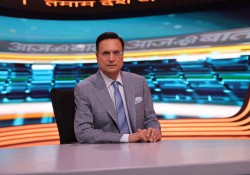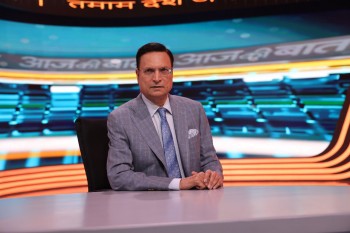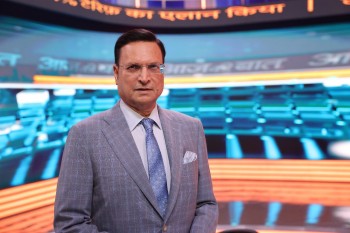
India-US ties : Trump Trouble is Temporary

US President Donald Trump has practically admitted that his remarks against India have worked adversely. He has admitted that he could not force Prime Minister Narendra Modi to accept his demands. Trump has publicly admitted that his 50 pc tariff move has alienated India from the US.
On Friday, Trump wrote on social media, “Looks like we’ve lost India and Russia to deepest, darkest, China. May they have a long and prosperous future together! President Donald J. Trump.” The remark was sarcastic, and, one the same day, while talking to reporters, Trump did his U-turn act.
Trump said: “I don’t think we have (lost India to China). I’ve been very disappointed that India would be buying so much oil, as you know, from Russia. And I let them know that.”
Trump extended an olive branch towards India. He said, “I always will, I will always be friends with Modi, he is a great Prime Minister, he is great….I just don’t like what he is doing at this particular moment, but India and the United States have a special relationship. There is nothing to worry about.”
In Delhi, Prime Minister Modi reacted on X on Saturday: “Deeply appreciate and fully reciprocate President Trump’s sentiments and positive assessment of our ties. India and the US have a very positive and forward-looking Comprehensive and Global Strategic Partnership.”
Donald Trump’s comment on Truth Social platform was no doubt sarcastic. It appears to be borne out of frustation. It also reflects his admission of mistake. For the first time, Trump gave the global power certificate to China and admitted that he is worried about India, Russia and China coming together.
Trump knows it is he who is responsible for pushing India towards China, but he is never going to admit that. The entire world has seen the excesses committed by Trump on India. He provoked Modi, tried to bully him, but the Indian Prime Minister was neither shaken, nor did he give in.
India’s reply was precise, calculated and targeted. American experts had been saying for last several days that it is Trump who converted an old friend like India into an enemy. Trump admitted his action through his social media comment.
The question is: Is the chasm between India and the US deep? Is it permanent? There are many in the US administration who say that Trump has a blow hot, blow cold habit. He has probably realised that breaking off friendly ties with India will prove to be a loss. None should be surprised if Trump changes his tune after some days, as he did on Saturday.
But India’s stand is quite clear. India-US relationship does not depend on the mood and fads of an individual. Today, the world is witnessing a changed India. It is not going to compromise on the issue of self-respect.
Get connected on Twitter, Instagram & Facebook

SCO summit : Modi’s answer to Trump’s Tariff War

India, Russia and China, along with other member states of Shanghai Cooperation Organisation(SCO) on Monday unanimously said, without naming the US, that the world will not tolerate “unilateral coercive measures including those of an economic nature, that contravene UN Charter and other norms of international law”.
It was a clear reference to steep tariffs imposed by US President Donald Trump on most of the countries of the world.
As pictures and videos of Prime Minister Narendra Modi with Russian President Vladimir Putin and Chinese President Xi Jinping made it to the front pages of world newspapers and prime time of world news channels, the headlines were evocative.
“Xi, Putin And Modi Try To Signal Unity At China Summit”, wrote The New York Times, “Behind the smiles with Putin, Modi and Xi at China Summit”, said CNBC, “Car-rides and hand holding: Putin, Modi and Xi send Trump a message at China Summit”, said NBC News, “Xi, Modi and Putin share a laugh at security commit” , wrote CNN.
And what was the message from Xi, Modi and Putin? Without naming the US or Donald Trump, they said, the world will run on the basis of mutual cooperation and any country trying to disturb world order or browbeat others to break business chains, will not be tolerated.
The New York Times wrote: “Their display of friendship in China was aimed at projecting an alternative to US global leadership..”.
Russian Foreign Ministry posted the pictures of the three top leaders as its “Picture of the Day”. Putin, after a warm hug and handshake, went with Modi to the dais. He requested Modi to join him in his high-security vehicle Aurus Senat. Putin waited for ten minutes for Modi to come and join him in the vehicle. The two leaders had a long tete-a-tete even after reaching their venue for bilateral talks.
Xi Jinping supported India’s stand on terrorism and said that the friendship between India, China and Russia will prove to be the balancing factor in the new world order.
Pakistan is a member of SCO and most of the SCO countries condemned the terror attack in Pahalgam. Pakistan Prime Minister Shehbaz Sharif sat and listened when Modi said, terrorism in any form will not be tolerated.
The outcomes of SCO Summit is a historic success for Prime Minister Narendra Modi’s diplomacy. Those who were saying that India’s foreign policy has failed, may have been shocked watching Modi, Putin and Xi meeting in a spirit of bonhomie.
Those who were claiming that Modi fears China, must have noticed how Modi said, in the face of the Pakistani Prime Minister on Chinese soil, that terror attacks will not be tolerated.
Those who were gratuitously teaching Modi the ropes of diplomacy must have noticed, Putin waiting in his vehicle for ten minutes for Modi to come and sit with him. Both the leaders had a tete-a-tete inside the car for nearly 50 minutes. Never had anybody seen such Putin in such a manner at any international gathering.
Those who were shouting, “Narender Surrender”, may have been shocked reading the statement issued by the US embassy in Delhi soon after the SCO summit was over.
It read, “The partnership between the United States and India continues to reach new heights — a defining relationship of the 21st century. This month, we’re spotlighting the people, progress, and possibilities driving us forward. From innovation and entrepreneurship to defense and bilateral ties, it’s the enduring friendship between our two peoples that fuels this journey.”
Those who were dancing in joy when Trump imposed 50 pc tariff on India, thereby creating a crisis for Modi, will be worried watching Modi, standing with Putin and Xi Jinping, trying to bring some balance in world order.
Even Donald Trump had to write on social media giving excuses on why he imposed a steep tariff on India.
The moot point is: Those who were criticising Modi’s foreign policy, were, in effect, trying to show India in a poor light. They must understand, whenever matters relating to foreign policy arise, whether in the form of challenges from the US or China, the entire nation should stand united, whosoever may be the Prime Minister, whosever may be running the government. National interest is above all.
Get connected on Twitter, Instagram & Facebook
India-China-Russia front: Modi diplomacy back on track
 The tariff war unleashed against India by US President Donald Trump appears to have indirectly led to a platform consisting of India, China and Russia. On Friday, Russia President Vladimir Putin spoke to Prime Minister Narendra Modi on phone. According to Modi, Putin apprised him of the latest developments on the Ukraine front. Both the leaders spoke about the need for strategic relationship. Modi said, he was keenly awaiting Putin’s India visit.
The tariff war unleashed against India by US President Donald Trump appears to have indirectly led to a platform consisting of India, China and Russia. On Friday, Russia President Vladimir Putin spoke to Prime Minister Narendra Modi on phone. According to Modi, Putin apprised him of the latest developments on the Ukraine front. Both the leaders spoke about the need for strategic relationship. Modi said, he was keenly awaiting Putin’s India visit.
In another interesting development, Chinese daily Global Times in its editorial has praised Prime Minister Modi and India. The newspaper article said it is a good development that Prime Minister Modi is going to visit China. This will encourage peace and stability in the region.
The editorial says: “As a Hindu proverb goes, ‘help your brother’s boat across, and your own will reach the shore’. A healthy China-India relationship brings positivde spillover effects to the region and the world. We welcome Prime Minister Modi to visit China with genuine intentions to improve bilateral ties and pragmatic cooperation plans, and to jointly usher in a new chapter of ‘the dragon and the elephant dancing together’.”
Meanwhile, US President Trump has put negotiations on India-US bilateral trade agreement on hold till the issue of tariff is cleared.
The manner in which Trump imposed 50 pc tariff on India makes one thing clear. That there was no deal by PM Modi with Trump, as is being alleged by people. Trump has claimed 32 times that he put pressure of trade deals on both India and Pakistan to accept a ceasefire. Trump did not mention about any deal.
It is now clear that Modi has not “surrendered” to Trump, as as being claimed by the opposition. On the other hand, Trump tried to provoke Modi at every step. But Modi maintained his dignity.
Trump to pressurize India consistently. he changed goal posts several times, but Modi did not compromise with national self-respect at any point.
Where are those people who were saying “Narender Surrender”. Where are those who were alleging that Modi had struck a tariff deal with Trump?
Trump continued to threaten India not to buy oil from Russia, and , on the other hand, he gave concessions to China. But Modi converted crisis to opportunity.
If India, Russia and China project a joint front, they can prcik Trump’s tariff balloon.
The most important point: the differences between India and China during the last five years have started vanishing courtesy Trump. The same China has now started speaking in favour of India. Where are those people who had been claiming that Modi’s diplomacy has failed?
Daring drone attacks by Ukraine : How will Putin retaliate ?
 In a meticulously planned and flawlessly executed operation, code named “Spiderweb”, Ukraine destroyed or damaged 41 Russian strategic bombers and surveillance aircraft, using 117 killer drones. These killer drones were carried in wooden cabins loaded on trucks to at least four locations deep inside Russian territory. The targets were four Russian air bases stretching from Finland border to Siberia, 4,500 km from the Ukrainian border.
In a meticulously planned and flawlessly executed operation, code named “Spiderweb”, Ukraine destroyed or damaged 41 Russian strategic bombers and surveillance aircraft, using 117 killer drones. These killer drones were carried in wooden cabins loaded on trucks to at least four locations deep inside Russian territory. The targets were four Russian air bases stretching from Finland border to Siberia, 4,500 km from the Ukrainian border.
By carrying out this daring and audacious strike, rules of modern warfare have now been re-written and questions hang over the fate of ongoing Russia-Ukraine war.
Russian air defences and radars were not prepared for such a sudden and low-altitude drone attack. The cheap First Person View (FPV) drone costs only Rs 25,000 ($300) a piece, and they destroyed or damaged Russian strategic bombers and other aircraft worth more than Rs 60,000 crore ($7 billion). Among the Russian aircraft destroyed were Tu-95, Tu-22 and Tu-160 long-range strategic bombers, and A-50 surveillance aircraft.
Soon afterwards, Russian Sukhoi-30 bombers attacked key locations inside Ukraine with missiles and swarms of more than 400 Russian drones were sent to bomb Sumi, Kharkiv, Donetsk, Zaporizhzhia and Kherson.
India’s Chief of Defence Staff Gen Anil Chauhan said, the modern warfare has now totally changed with small killer drones replacing costly jet fighters and missiles. He said, with the entry of Artificial Intelligence, future wars may be fought between machines and not human beings, with the help of intelligent and automated kill-chains.
The daring attacks that took place on June 1 in the blink of an eye has set new rules of modern warfare, where technology and brains matter more than the might of weapons.
Russia was confident that no enemy could touch its strategic bombers located several thousand km deep inside its vast territory, in different regions. It was particularly confident about Ukraine, which has a small army and has no capability to reach those air bases. But, at the end of the day, after 18 months of consistent efforts, Ukrainian intelligence did wonders.
This is a highly embarrassing moment for Russian President Vladimir Putin. These drone attacks have changed the definition of modern warfare. US President Donald Trump will be more worried. He had bombastically claimed that he had made both Putin and Ukrainian President Volodymyr Zelenskyy agree to a ceasefire. His plans have now gone awry. Both the countries have escalated the war again.
In the White House, during the infamous standoff in front of cameras, Trump had bluntly told Zelenskyy in his face, “you have no cards to play”.
Zelenskyy has now showed one of the cards that he had kept hidden with him. He has now changed the game. Ukraine, which appeared to be a meek nation in the face of mighty Russia, can now sit at the negotiation table with its head held high. Ukrainian counterparts can now speak to Russian leaders by looking into their eyes.
India too had used drones to destroy terror bases inside Pakistan in precise and controlled attacks. These terror bases had got air defence cover from Pakistan Air Force, but they were reduced to rubble.
Bangladesh : Is China fishing in troubled waters?
Bangladesh, like Pakistan, is deep in debt and is yearning to sit in the lap of Chinese lenders. The chief adviser of the interim government Mohammed Yunus has appealed to China to grant loans and make investments.
At an investors’ summit in Dhaka with Chinese companies, Yunus said, a huge Chinese investment can become a gamechanger for Bangladesh’s economy. He invited Chinese industrialists to invest in textiles, pharma, fisheries, jute and IT sectors. There are reports that China is going to build the world’s biggest seaport in Bangladesh.
Already, China provides 90 per cent of raw material for Bangladesh’s textile sector. Due to instability and lack of elected government, Bangladesh’s economy is now in doldrums. China is trying to fish in troubled waters and draw Bangladesh into its sphere of influence.
Meanwhile, the caretaker government is trying to finish off former PM Sheikh Hasina’s political existence. A special tribunal began proceedings to try Sheikh Hasina for charges of crimes against humanity filed against her in connection with the mass students’ uprising in which more than 1,500 people were killed and more than 25,000 people were injured last year. Sheikh Hasina had to resign and leave Bangladesh in a hurry. Apart from Hasina, her former Home Minister Asaduzzaman Khan and former police chief Chowdhury Abdullah Al Mamum have been made accused. The tribunal has directed investigators to produce Hasina and others before the court on June 16.
In another development, Bangladesh Supreme Court has cleared the path for Jamaat-e-Islami to get back its registration as a political party. The interim government has removed ban on Jamaat-e-Islami. While Yunus has promised to hold parliamentary elections by June next year, the mainstream Bangladesh Nationalist Party headed by Khaleda Zia, wants elections to be held early, by December this year.
The political scene in Bangladesh is changing at a fast pace and Chinese interference is on the rise. The interim government has started removing the image of Sheikh Mujibur Rahman from all currency notes. By removing ban on Jamaat-e-Islami, Yunus’ government is aiming to prop up this Islamic fundamentalist party as a counter to Khaleda Zia’s BNP.
Jamaat-e-Islami wants Bangladesh to become a conservative Islamic Republic. If that happens, it can cause concerns for India. Bangladesh seems to be heading towards a future that the world has already seen in Pakistan.